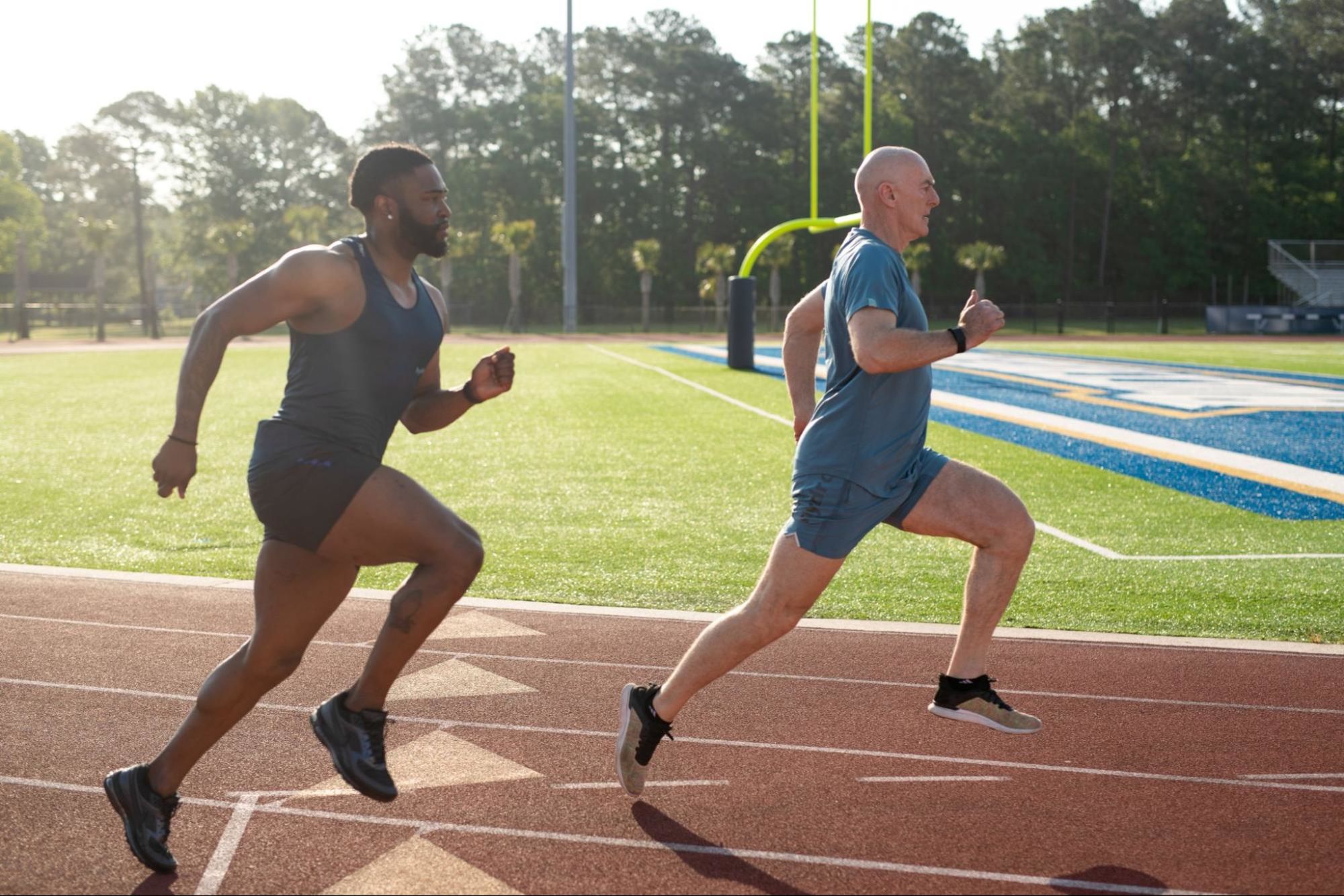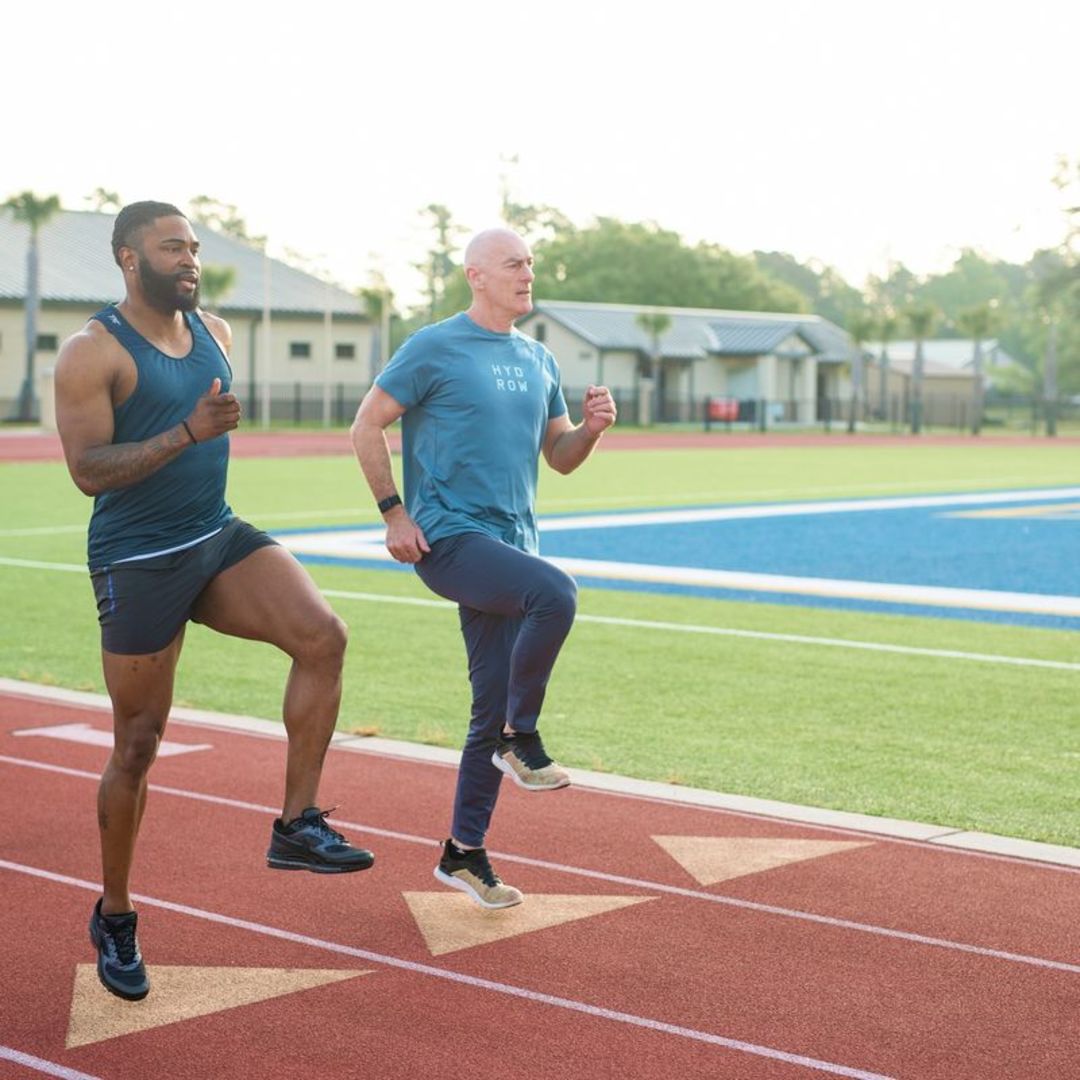What Is HIIT Training?

High-intensity interval training (HIIT) is a popular and highly effective form of cardiovascular exercise that has gained widespread recognition for its ability to provide numerous health benefits and efficiently improve fitness levels.
If you’re looking to learn more about what HIIT training is, read on to find out:
Let’s get started!
What does HIIT training look like?
HIIT workouts are characterized by short bursts of intense exercise followed by brief periods of rest or low-intensity recovery.
HIIT usually incorporates either running-, cycling-, or rowing-based modes of exercise and is an efficient exercise regimen for eliciting cardiopulmonary and metabolic adaptations.
Why is HIIT training good for you?
This training approach differs significantly from traditional steady-state cardio exercises, such as walking, jogging or cycling, where individuals maintain a consistent, moderate intensity throughout the session.
No two circuit training workouts will necessarily look the same. The types of exercises included in HIIT workouts can vary considerably depending on your performance, health goals, experience and ability to perform the specified movements.
The principles behind HIIT, its mechanisms, and its many advantages
HIIT workouts typically involve a series of high-intensity intervals, ranging from 20 seconds to 90 seconds, where individuals exert themselves close to their maximum capacity. These intense periods are interspersed with shorter recovery intervals, usually lasting 20 seconds to 90 seconds, during which individuals perform low-intensity exercises or simply rest.
The ratio of work-to-rest periods can vary depending on the specific HIIT protocol being followed. Common examples include:
The Tabata method, which consists of 20 seconds of intense exercise followed by 10 seconds of rest
The 2:1 method, with 30 seconds of work followed by 15 seconds of rest
What are the benefits of HIIT training?
The effectiveness of HIIT training can be attributed to several physiological mechanisms, with the benefits of HIIT training including:
Boosting your cardio
Increasing your metabolic rate and calorie burn
Improving insulin sensitivity and glucose metabolism
Helping with fat loss
Building muscle
Serving as an efficient workout
Let’s dig in more!
1. Boosting your cardio
First and foremost, HIIT increases the cardiovascular demand on the body, forcing the heart to work harder and pump more blood with each contraction. This leads to improved cardiovascular fitness and increased stroke volume, allowing the heart to pump more blood with each beat.
These high-intensity intervals also elevate heart rate, enhancing cardiovascular conditioning.

What’s your fitness style?
Take our quiz and receive a customized 14-day training program.
2. Increasing your metabolic rate and calorie burn
HIIT has also been shown to boost metabolic rate significantly. The intense exercise periods stimulate the body to burn more calories both during the workout and in the post-exercise recovery phase.
This phenomenon is often referred to as the "afterburn effect" or excess post-exercise oxygen consumption (EPOC). During EPOC, the body expends energy to restore physiological functions to their pre-exercise state, such as replenishing oxygen stores, repairing muscle tissue, and removing metabolic waste products. This process can lead to an increased calorie burn that can persist for hours after the workout.
3. Improving insulin sensitivity and glucose metabolism
HIIT is also highly effective for improving insulin sensitivity and glucose metabolism. Short bursts of high-intensity exercise stimulate glucose uptake in muscles, helping to regulate blood sugar levels. This is particularly beneficial for individuals at risk of or already dealing with type 2 diabetes or insulin resistance.
4. Helping with fat loss
HIIT can have a positive impact on fat loss. It promotes the release of catecholamines, such as adrenaline, which enhance lipolysis (the breakdown of fat). Combined with the increased calorie burn and metabolic rate, HIIT can contribute to fat reduction and improved body composition.

Explore Hydrow's library of 5,000+ rowing, circuit training, yoga, Pilates, and mobility workouts.
5. Building muscle
A study published in the Journal of Applied Physiology in 2008 examined the effects of HIIT on muscle mass and found that it resulted in similar or even greater gains in muscle mass compared to traditional steady-state cardio.
This is significant because preserving muscle mass is crucial for maintaining a healthy metabolism and preventing muscle loss often associated with prolonged aerobic training.
6. Serving as an efficient workout
In addition to its physiological benefits, HIIT is known for its time efficiency. Many people find it challenging to commit to long, steady-state cardio sessions. HIIT workouts, on the other hand, can be completed in as little as 20 to 30 minutes, making them a convenient option for those with busy schedules.
A study published in the Journal of Sports Medicine and Physical Fitness in 2015 compared the effects of 10 weeks of HIIT with traditional moderate-intensity continuous training. The results showed that HIIT produced similar or better improvements in body composition and aerobic fitness in significantly less time. Who doesn’t like efficiency?
Related Blog: 28 Best HIIT Workouts for Beginners
Three examples of HIIT workouts
If you’re looking to get started with HIIT training, here are three examples that put these HIIT principles into practice.
1. Tabata sprints
Warm up with five minutes of light jogging or jumping jacks.
Sprint at maximum effort for 20 seconds.
Rest for 10 seconds (stand still or walk slowly to catch your breath).
Repeat the cycle for a total of eight rounds (four minutes).
Cool down with five minutes of light jogging or walking.
2. Bodyweight HIIT circuit
Perform each exercise for 45 seconds, followed by a 15-second rest between exercises.
Exercises:
Jump squats
Push-ups
Burpees
Mountain climbers
High knees
After completing all exercises, rest for one to two minutes.
Repeat the circuit for three to four rounds.
3. Rowing HIIT workout
Warm up on your row machine for five minutes by rowing at a moderate pace, focusing on your technique and connection between your hands and your feet.
Row “hard” at a rate that’s two to four strokes faster than your warm-up pace, where you’ll see your split times get faster. Hold that for 30 seconds.
Slow down and row at a relaxed pace for 60 seconds. This could be back at your warm-up pace.
Repeat the cycle for 10–15 minutes.
Finish with a five-minute cooldown, gradually reducing your pace.
Make sure to stretch for five minutes afterwards.
Remember to adjust the intensity and duration of your HIIT workouts according to your fitness level and goals. Despite its many advantages, HIIT may not be suitable for everyone. It can be physically demanding and may pose a risk to individuals with certain medical conditions or limited fitness levels. It's essential for individuals to consult with a healthcare provider before starting a HIIT program, especially if they have any underlying health concerns.
Final thoughts: What is HIIT training?
In conclusion, high-intensity interval training (HIIT) is a highly effective and time-efficient form of exercise that involves short bursts of intense activity followed by brief recovery periods. HIIT offers numerous physiological benefits, including improved cardiovascular fitness, increased metabolic rate, enhanced insulin sensitivity, and fat loss.
Its efficiency and versatility also make it a popular choice for individuals looking to optimize their fitness and health within a limited timeframe. However, it's crucial for individuals to approach HIIT with caution and seek guidance from a healthcare provider or fitness professional, particularly if they have pre-existing medical conditions or are new to exercise.
If you’re looking to incorporate HIIT training into your workout regimen, be sure to check out the Hydrow app, which features over 5,000 workouts led by world-class Athletes.

Explore Hydrow
Learn more about how you can transform your fitness routine with a rowing machine.




